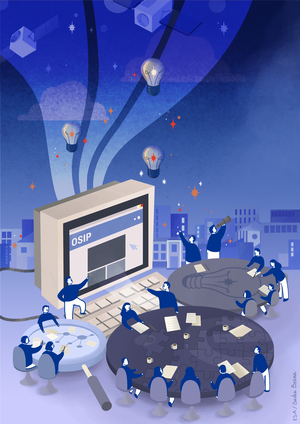Accept all cookies Accept only essential cookies See our Cookie Notice

About ESA
The European Space Agency (ESA) is Europe’s gateway to space. Its mission is to shape the development of Europe’s space capability and ensure that investment in space continues to deliver benefits to the citizens of Europe and the world.
Highlights
ESA - United space in Europe
This is ESA ESA facts Member States & Cooperating States Funding Director General Top management For Member State Delegations European vision European Space Policy ESA & EU Space Councils Responsibility & Sustainability Annual Report Calendar of meetings Corporate newsEstablishments & sites
ESA Headquarters ESA ESTEC ESA ESOC ESA ESRIN ESA EAC ESA ESAC Europe's Spaceport ESA ESEC ESA ECSAT Brussels Office Washington OfficeWorking with ESA
Business with ESA ESA Commercialisation Gateway Law at ESA Careers Cyber resilience at ESA IT at ESA Newsroom Partnerships Merchandising Licence Education Open Space Innovation Platform Integrity and Reporting Administrative Tribunal Health and SafetyMore about ESA
History ESA Historical Archives Exhibitions Publications Art & Culture ESA Merchandise Kids Diversity ESA Brand Centre ESA ChampionsLatest
Space in Member States
Find out more about space activities in our 23 Member States, and understand how ESA works together with their national agencies, institutions and organisations.
Science & Exploration
Exploring our Solar System and unlocking the secrets of the Universe
Go to topicAstronauts
Missions
Juice Euclid Webb Solar Orbiter BepiColombo Gaia ExoMars Cheops Exoplanet missions More missionsActivities
International Space Station Orion service module Gateway Concordia Caves & Pangaea BenefitsLatest
Space Safety
Protecting life and infrastructure on Earth and in orbit
Go to topicAsteroids
Asteroids and Planetary Defence Asteroid danger explained Flyeye telescope: asteroid detection Hera mission: asteroid deflection Near-Earth Object Coordination CentreSpace junk
About space debris Space debris by the numbers Space Environment Report In space refuelling, refurbishing and removingSafety from space
Clean Space ecodesign Zero Debris Technologies Space for Earth Supporting Sustainable DevelopmentLatest
Applications
Using space to benefit citizens and meet future challenges on Earth
Go to topicObserving the Earth
Observing the Earth Future EO Copernicus Meteorology Space for our climate Satellite missionsCommercialisation
ESA Commercialisation Gateway Open Space Innovation Platform Business Incubation ESA Space SolutionsLatest
Enabling & Support
Making space accessible and developing the technologies for the future
Go to topicBuilding missions
Space Engineering and Technology Test centre Laboratories Concurrent Design Facility Preparing for the future Shaping the Future Discovery and Preparation Advanced Concepts TeamSpace transportation
Space Transportation Ariane Vega Space Rider Future space transportation Boost! Europe's Spaceport Launches from Europe's Spaceport from 2012Latest

How Mars turned red
Thank you for liking
You have already liked this page, you can only like it once!
The Red Planet Mars got its iconic colour from a combination of rusting and erosion over its 4.6-billion-year history.
Mars was a once wetter place than the dry, barren world we know today. During its early history, iron in its rocks reacted with oxygen and water to create rust. The rust was washed into the rivers, lakes and seas that used to cover Mars, becoming incorporated into the underlying rocks. Volcanic activity could also have triggered ice-melting events, further contributing to this process.
Once Mars dried out, this rusty rock was broken down into dust over billions of years. Strong winds blew this dust all over the planet’s surface, gradually turning Mars red.
Signatures of the water-rich environment in which the rust formed are still preserved in the dust, as analysed by spacecraft studying Mars today.
Click here for an animated GIF version of this infographic
[Image description: Graphic showing how Mars turned from a grey, wet planet into a dusty red planet. From left to right, four steps are illustrated in a single image. First, iron in the planet’s rocks react with oxygen and water to create rust. Then the rust is washed into rivers, lakes and seas, and becomes incorporated in the underlying rocks. A volcano is also shown to represent a heat source that may have melted ice, further washing the rust into pools. Over billions of years the rusty rock is broken down into dust. Finally, winds blow the dust around the planet. A rover is shown on the surface, representing the direct analyses of this rusty dust. An orbiting spacecraft surveys the scene from above.]
-
CREDIT
ESA -
ACKNOWLEDGEMENTS
ATG Europe, based on Valantinas et al (2025) -
LICENCE
CC BY-SA 3.0 IGO or ESA Standard Licence
(content can be used under either licence)

Why is Mars red?

Mars dust map

Sunburnt country

Metallic Mars















 Germany
Germany
 Austria
Austria
 Belgium
Belgium
 Denmark
Denmark
 Spain
Spain
 Estonia
Estonia
 Finland
Finland
 France
France
 Greece
Greece
 Hungary
Hungary
 Ireland
Ireland
 Italy
Italy
 Luxembourg
Luxembourg
 Norway
Norway
 The Netherlands
The Netherlands
 Poland
Poland
 Portugal
Portugal
 Czechia
Czechia
 Romania
Romania
 United Kingdom
United Kingdom
 Slovenia
Slovenia
 Sweden
Sweden
 Switzerland
Switzerland

























